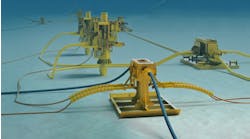Offshore staff
STAVANGER, Norway – Statoil has contracted Aker Offshore Partner, a subsidiary of Aker Solutions, for subsea compression topside modifications on the Åsgard field in the Norwegian Sea.
The Åsgard license partners have opted for seabed compressors - a world first - in order to extend the producing life of the Åsgard A platform, and the Mikkel and Midgard reservoirs. The proposed solution could enhance recovery by 28 bcm of gas and 14 MMbbl of condensate.
The purpose of the topsides modifications is to supply electricity to the subsea compressor units, which will be installed in 2013.
Aker’s scope of work includes building and installing an 800-metric ton (882-ton) module, and integration work on the Åsgard A and B platforms. Delivery is scheduled for Q4 2014. The contract value is around $116 million.
The project will be managed from Aker Solutions’ offices in Trondheim, Norway, and executed jointly with the company’s branch in Egersund.
Contracts for pipelines, marine operations and other major procurement items in connection with the project will be awarded later this year.
Statoil is also looking to implement seabed gas compression to boost recovery from the Gullfaks South field in the North Sea.
Since 2008, the license partners have worked with Framo Engineering to develop technology for compressing wet gas on the seabed.
“This could increase production from the field by 3 bcm of gas, which means a 6% increase in recovery,” said Ivar Aasheim, Statoil’s head of field development on the Norwegian shelf.
The current field recovery rate is 62%, but the combination of subsea compression and conventional low pressure production in the later phases could lift the recovery rate to 74%.
The standard solution to combat field pressure decline is compression on a platform or from land. Statoil points out, however, that the closer the compression can be placed in relation to the well, the more gas can be extracted. This is because the compressor’s suction pressure will be lower than if the compressor is installed on a platform. When the gas is compressed, it will then have enough pressure for transport up to the platform.
Statoil is working on a similar seabed solution with Norske Shell for the Ormen Lange field in the Norwegian Sea, and has identified further small and mid-size fields that might also benefit.
The plan for the Åsgard and Ormen Lange fields calls for the use of a conventional compressor. Here, the moisture is removed from the gas before it is compressed on the seabed. On Gullfaks South, the well stream will flow directly into a well stream mixing module before the total well stream is compressed.
This compression technology was tested last month at Framo Engineering’s test facilities in Fusa outside Bergen, with a hydrocarbon blend corresponding to the Gullfaks satellites.
06/20/2011


